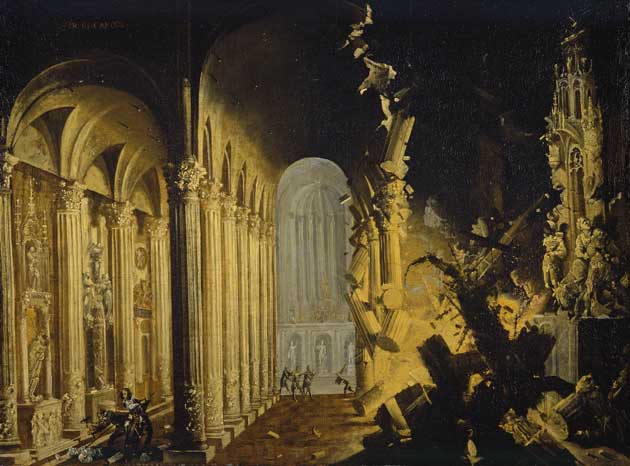Great Works: An Explosion In A Church (1630s), François de Nomé
Fitzwilliam Museum, Cambridge

Bang. It's one of our favourite spectacles, and even the events of September 2001 haven't taken the shine off it. The demolition of a tower block is caught at the very instant when the charges are blown near its base. At these moments, three forms of modern technology come together in a perfect junction: high-rise architecture, controlled explosive, split-second photography. Bang.
You may prefer to watch a moving film showing the whole process though to the end. And it's true, we wouldn't enjoy the exploding moment if we didn't know what was going to happen next: the building's rather stately and neatly vertical descent, as it compacts into the ground.
But the suspended point before the collapse, when the still upright structure is punctuated by the sudden blast-cloud of concrete-dust, is a point to hold on to.
The camera has taught us about instants. It's made them visible as never before. Over the past century it's simply become the normal way to image the world. Photography started with very long exposure times. But by the 1870s Eadweard Muybridge's records of a galloping horse were using shutter speeds of 1,000th of a second.
The snapshot has often revealed that the instantaneous is not what we'd expected. Muybridge's experiment showed (contrary to what paintings had always depicted) that a galloping horse never has all four hooves off the ground simultaneously. Still, we shouldn't exaggerate the ignorance of moments among pre-photo artists.
François de Nomé's An Explosion in a Church is an obscure picture that became famous in the 20th century as a piece of fantasy art. Like Arcimboldo and Hieronymus Bosch, De Nomé was one of those artists who were picked up by the Surrealists and promoted as one of their forerunners. His weird architectural views, luridly illuminated, suggested to them the visions of deranged mind.
But if the painter had visions, he was inclined to disguise them as more conventional story telling. There's a small inscription in the top left corner, an abbreviated Bible reference, pointing us to the First Book of Kings, Chapter 15, telling of the pious King Asa who destroyed some idols. (The picture has an alternative title: King Asa of Judah Destroying the Idols.) The connection is tenuous and anachronistic. The Old Testament has no mention of fire or even a temple.
Never mind De Nomé's supposed visions. Never mind these hints of narrative. And never mind the other possible readings of the scene: that we see Protestant iconoclasts at their breaking work in Northern Europe; that it was the menacing proximity of Mount Vesuvius to Nomé's workplace in Naples that filled his imagination with thoughts of disaster.
It's the explosion that's the making of An Explosion in a Church. This isn't a subtle work, or a particularly lovely one, but as a painting of a sudden bang it is unique.
The image divides in two, a simple bit of visual dramatisation. On the right, all upright; on the left, all chaos. The Corinthian columns stand in solid rows, and then flick the eye and the scene becomes almost unreadable – a cloud of glare, a silhouette pile of rubble, a lightning gash of broken roof, the shattered sculptured altarpiece, the dust and sparks. It's like "before" and "after": from architectural record to ruin and wreckage.
At least, that's one way of pacing the picture. But you can also see it as doing a 1-2-3, as you start with the columns fixed against the left wall, then move on to the second free-standing row, and then on to the third row which, if they stood unbroken, would be lined up almost directly with the viewer's line of sight.
These columns are the climactic point. They give us the delight not just of a destruction but of instantaneousness. This is an image that knows about the photographic moment, and knows about it centuries before photography arrived. We may never see the moving world stopped miraculously in its tracks, but we can imagine it, and De Nomé has imagined it here.
Of course, there's calculation in the effect, just as there's often calculation in the camera's decisive moments. There would be many ways in which both a painter and a snapper could show or catch this kind of event that didn't seem so sudden, so split-second.
But this instant is electrifying. The broken drums of the columns are flung out, tumbling in mid-air. Their random staccato angles carry physical excitement. You want to "conduct" their criss-cross, choppy lines with your hands. Meanwhile, against these diagonals, some of the columns are still vertical, but hovering, promising their imminent plunging descent. It's the blown-up tower-block, ahead of the game.
About the artist
François de Nomé (c1593-c1650) is very little known. He often does not appear in art dictionaries. He used to be known by a quite different name, Monsù Desiderio (which you may not find either), but which was a name that in fact got attached to three quite different artists, all working, like him, in Naples in the early 17th century, and which are now separated out. De Nomé had come from Lorraine. He specialised in mysterious scenes of imaginary churches and disasters and flash-lit ruins and hell – connected perhaps to the undercurrent of paganism, witchcraft and magic in Neapolitan culture.
Join our commenting forum
Join thought-provoking conversations, follow other Independent readers and see their replies
Comments
Bookmark popover
Removed from bookmarks